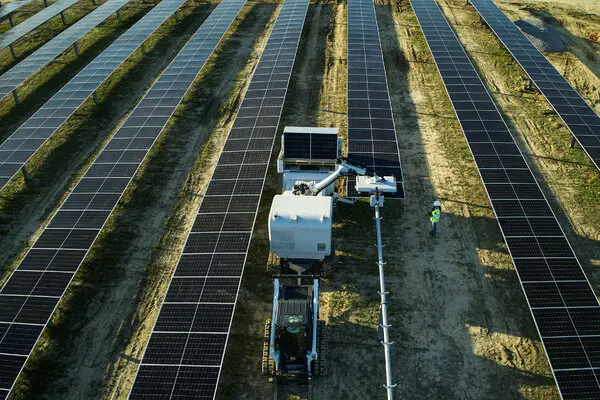By: Matthew Wang
AES corporation, one of the largest solar tech corporations and a Fortune 500 company, unveiled its new solar farm construction robot, Maximo, on July 30, 2024. The robot was developed in response to labor shortages and to speed up construction in the company’s often unwieldy construction sites.
Maximo is composed of a tracked chassis capable of holding a variety of different types of solar panels, a mechanical arm that utilizes suction cups to grab the panels, and a small side unit to attach the panels to their mounts. This robotic body is then controlled by an advanced artificial intelligence to most efficiently adapt to different environments and cope with the environmental factors not present in assembly lines.
With this highly sophisticated technology, AES states that their robot is capable of assembling these solar arrays twice as fast as a typical crew of human laborers would while also replacing the arduous work of assembling these solar arrays manually since the panels weigh up to 80 lbs each.
Due to rising solar demands all over the globe, projects like Maximo have become more and more common as solar companies attempt to support their insufficient labor forces. As many tech companies attempt to secure renewable energy for their data centers and servers, there has been a growing demand for large solar installations, a demand that solar companies are struggling to supply. According to a survey by the Interstate Renewable Energy Council (IREC), roughly 44% of solar companies felt it was difficult finding qualified workers, thus leaning into automation to achieve its results.
However, this new technology was not without its flaws, especially with training the robot to deal with the unique conditions of each worksite. According to The New York Times, the AES team working on the robot experienced a variety of issues, with the most prominent one being glare. The same report stated that, “When the robot moved from New York to Ohio for testing, it suddenly faced different angles of sunlight reflecting off modules and the company’s engineers had to train the robot to adapt.” Due to the variety of different worksites the robot could encounter, lacking the ability to adapt was a major issue, especially in the desert, where the majority of solar construction was done.
However, as AI technology continues to mature, it is expected to have a growing importance in the construction and maintenance of solar panels among other renewable energy sources. Already, AI is being used to optimize the solar panels’ efficiency, turning them towards the direction of light. With this quickly growing technology already showing its potential, AI and in turn, robotics, is slated to continue to be a deciding factor in the promising industry of solar power.











